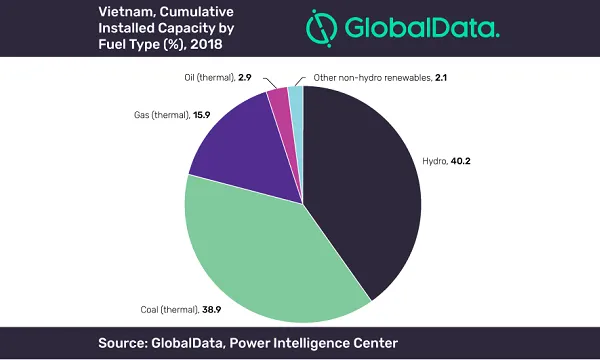
Non-hydro renewables in Vietnam to grow 22.4% annually: report
The government looks to expand its energy mix as its coal reserves gradually deplete.
Non-hydro renewables in Vietnam could grow at a whopping annual rate of 22.4% and hit a total capacity of 19.9GW by 2030, thanks to government policies and the untapped renewable potential, according to GlobalData.
The country has been struggling to develop its energy industry due to a lack of state funds, it said in a report. “The country’s coal reserves are depleting, and the government is looking to expand the energy mix.”
Anchal Agarwal, power industry analyst at GlobalData, commented, “In Vietnam, market development of renewable sources such as wind and solar is in nascent stage. Hydropower potential is nearly exploited; in contrast, wind, and solar expansion potentials are high and to a great extent untapped.”
Against this backdrop, Vietnam has revised its seventh Power Development Plan (PDP7) and set the priorities for developing renewable energy sources such as wind, solar, and biomass. Projections are to increase the percentage of renewable energy power to 7% by 2020 and 10% by 2030, Agarwal added.
Also read: Winds of change: Vietnam pushes for more developments amidst growing energy demand
As of 2018, hydropower dominated the Vietnam power mix, with a share of 40.2% of the total installed capacity, followed by coal and gas with 38.9% and 15.9% share respectively. Non-hydro renewable power technologies accounted for a share of 2.1% in 2018, out of which, 1.3% was contributed by biopower, followed by wind and solar with 0.5% and 0.3% respectively.
As a percentage of the total installed capacity, the share of hydropower is expected to decline from 40.2% in 2018 to 23.0% in 2030 as it will be replenished by an increase in non-hydro renewable energy sources. “Wind and solar power are expected to be frontrunners in terms of non-hydro renewable energy resources,” Agarwal added.
However, there are several challenges currently facing the Vietnam power sector. The country’s biggest challenge is how to mobilize the large investment requirements, estimated at around $8b annually to meet fast growing power demand.
“Low electricity prices, limited funding, slow pace of major power projects and lack of private sector interest, including that of foreign investors, are some of the other challenges facing by Vietnam’s power sector,” Agarwal added.








![Cross Domain [Manu + SBR + ABF + ABR + FMCG + HBR + ]](https://cmg-qa.s3.ap-southeast-1.amazonaws.com/s3fs-public/styles/exclusive_featured_article/public/2025-01/earth-3537401_1920_4.jpg.webp?itok=WaRpTJwE)
![Cross Domain [SBR + ABR]](https://cmg-qa.s3.ap-southeast-1.amazonaws.com/s3fs-public/styles/exclusive_featured_article/public/2025-01/pexels-jahoo-867092-2_1.jpg.webp?itok=o7MUL1oO)









 Advertise
Advertise


